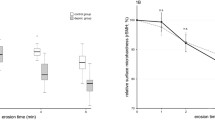Abstract
Amino-acid analyses showed that proline, glutamic acid and leucine were the most common amino acids in immature or developing enamel and in each of its fractions (i.e., in the 1st and 14th water-extractable fractions of a sequential series of extractions, EDTA-water-soluble and water-insoluble fractions). The immature enamel and its 1st and 14th water-extractable fractions were similar in their proportions of the basic amino acids (lysine, histidine and arginine), the B-hydroxylated aliphatic amino acids (serine and threonine) and some of the nonpolar amino acids (valine, leucine, and isoleucine). On the other hand, the immature enamel differed from the water-extractable fractions chiefly in its relative content of aspartic acid, glutamic acid, alanine, proline, glycine, tyrosine and methionine. Also the 1st water-extractable fraction differed from the 14th in its amino-acid profile. The EDTA-water-soluble fraction most closely resembled the 14th water-extractable fraction except for its proportion of arginine and alanine residues. Although with polyacrylamide gel electrophoresis the EDTA-water-soluble and the water-extractable fractions exhibited companion bands (at least 7 peaks were evident at pH 9.3) they differed decidedly as to which band was the most prominent. The water-insoluble fractions compared with any of the soluble fractions or with immature enamel showed a higher percent of serine, threonine, glycine, aspartic acid, alanine, valine, lysine, and arginine but relatively less glutamic acid, proline, methionine and histidine. Neither hydroxyproline nor hydroxylysine were detected in any of the samples.
Similar content being viewed by others
References
Burgess, R. C., Maclaren, C. M.: Proteins in developing bovine enamel. In: Proceedings of the second international symposium on the composition properties, and fundamental structure of tooth enamel, April 6–7, 1964 (Stack, M. V., Fearnhead, R. W., eds.), p. 74–82, Bristol: John Wright & Sons Ltd. 1965
Duggan, D. E., Udenfriend, S.: The spectrophotofluorometric determination of tryptophan in plasma and of tryptophan and tyrosine in protein hydrolysates. J. biol. Chem.223, 313–319 (1956)
Elwood, W. K., Apostolopoulos, A. X.: Analysis of developing enamel of the rat: I. Fractionation; Protein and calcium content. Calcif. Tiss. Res.17, 317–326 (1975)
Fincham, A. G.: Electrophoretic and sephadex gel filtration studies of bovine foetal enamel matrix at acid pH. Calcif. Tiss. Res.2, 353–360 (1968)
Glimcher, M. J., Krane, S. M.: The identification of serine phosphate in enamel proteins. Biochim. biophys. Acta (Amst.)90, 477–483 (1964)
Katz, E. P., Mechanic, G. L., Glimcher, M.J.: The ultracentrifugal and free zone electrophoretic characterization of the neutral soluble proteins of embryonic enamel. Biochim. biophys. Acta (Amst.)107, 471–484 (1965)
Levine, P. T., Glimcher, M. J., The isolation and amino acid composition of the organic matrix and neutral soluble proteins of developing rodent enamel. Arch. oral Biol.10, 753–756 (1965)
Levine, P. T., Glimcher, M. J., Krane, S. M.: The identification and isolation of serine phosphate in the developing proteins of rodent enamel. Arch. oral Biol.12, 311–313 (1967a)
Levine, P. T., Seyer, J., Huddleston, J., Glimcher, M. J.: The comparative biochemistry of the organic matrix proteins of developing enamel. I. Amino acid composition. Arch. oral Biol.12, 407–410 (1967b)
Mechanic, G. L., Katz, E. P., Glimcher, M. J.: The sephadex gel filtration characteristics of the neutral soluble proteins of embryonic bovine enamel. Biochim. biophys. Acta (Amst.)133, 97–113 (1967)
Meyer, T. S., Lamberts, B. L.: Use of Coomassie Brilliant Blue R250 for the electrophoresis of microgram quantities of parotid saliva proteins on acrylamide-gel strips. Biochim. biophys. Acta (Amst.)107, 144–145 (1965)
Moore, S., Spackman, D. H., Stein, W. H.: Chromatography of amino acids on sulfonated polystyrene resins, Analyt. Chem.30, 1185–1190 (1958)
Stack, M. V.: Chemical organization of the organic matrix of enamel. In: Structural and chemical organization of teeth, vol. II (Miles, A. E. W., ed.), p. 317–346, New York: Academic Press 1967
Author information
Authors and Affiliations
Rights and permissions
About this article
Cite this article
Elwood, W.K., Apostolopoulos, A.X. Analysis of developing enamel of the rat. Calc. Tis Res. 17, 327–335 (1975). https://doi.org/10.1007/BF02546604
Received:
Accepted:
Issue Date:
DOI: https://doi.org/10.1007/BF02546604




